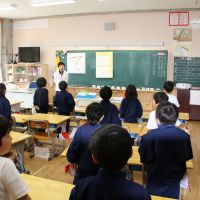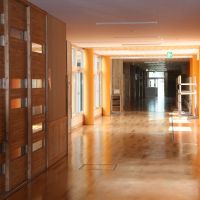Since 1980, I have made my home in Shinano, a town in northern Nagano Prefecture. However, in articles, letters and speeches, I refer to this area as Kurohime, the name of our local train station and of the great, dormant, densely forested volcano that looks down on us. I prefer to say my home is in Kurohime, which means Black Princess, because it not only sounds more romantic — being steeped in the legend of a black dragon who sweeps off with a human princess to make their home in the volcano — but also because there is an area in Tokyo called Shinanomachi, which confuses people.
Although I have lived here for 32 years, three of my children were schooled, and now live, in Canada. My youngest daughter, who's now in her 20s, went to school in Tokyo and England. This means that I have never been a participant in the local Parent-Teacher Association (PTA), which I now rather regret.
Ever since I was a rebellious little Welsh boy sent to school in neighboring England, I have generally hated school and consider most of them to be kinds of prisons for kids.
Despite this, when the people of Higashi-Matsushima in Miyagi Prefecture, whom we invited to our Afan Woodland Trust here last August, asked us to help them with the relocation and rebuilding of schools destroyed in last year's Great East Japan Earthquake and tsunami on March 11, I promised to do all that we could to help.
As I have written previously in this column — including as recently as April 1, in a Notebook headlined "Woodland therapy yields Tohoku school 'dream' " — the schools needed to be relocated from the coastal lowland to densely forested and untended hillocks immediately adjacent. Until the people visited our woods, which we have trimmed, planted and nurtured since 1986, they had a strong and depressing image of woodland being dark, forbidding and impenetrable. In contrast, our Afan woods are light, joyous and full of life.
We went to see the area, and soon began scientific biological assessments. We concluded that the proposed hilly, densely wooded site would be a wonderful place to have a school — as long as nature was respected (dare I say consulted?) and that they did not try to severely alter the face of the land with heavy earth-moving equipment. In other words, as long as they weren't bent on stripping all the vegetation and bulldozing the hillocks and little valleys flat in order to build a typically ugly ferro-concrete box on a flattened plot.
We suggested classrooms, offices, a library and so on built of wood; simple, elegant and well constructed, definitely, but also equipped with the most advanced safety and communications equipment.
I prefer to be anecdotal, and not to cherry-pick through the Internet for wiki-wisdom or whatever, but a lot of stuff on wooden schools is to be found there, and I offer a few examples:
For instance, in voicing an argument for using wood in schools, Pat Schiesman, of the Engineering Wood Association, a 70-year-old organization linked to the South Carolina Forestry Association in the United States, writes, "Wooden schools offer excellent performances in earthquakes and high winds, so they are common in California."
I note that with a forest cover of about 67 percent, South Carolina is similar to Japan, although, unlike in Japan, the wood sector of South Carolina's economy is the state's largest manufacturing employer. We badly need that kind of employment here !
I am also confident that modern laminated-wood beams are not only lighter than steel, but that they stand up better to fire. In this respect, I found on the Internet that Scott Lockyear, technical director with Woodworks of Georgia, again in the United States, reports that in a controlled fire test by the National Forest Products Association, researchers exposed comparable steel beams and so-called glulam (laminated-wood) beams to the same fire conditions for the same length of time. After 30 minutes, the steel beam had lost 90 percent of its strength and collapsed, while the glulam beam remained straight and true, laving lost just 20 percent of its strength.
Wood is not only lighter than steel, which helps buildings stand up to earthquakes, but it is also more ductile — meaning it can be bent or flexed without losing toughness (think of a yew longbow). This quality allows the energy of a temblor to dissipate through a structure by flexing it rather than fracturing it. Wood also has excellent sound absorption and, for the concerned environmentalist, wooden buildings store carbon.
Wood, especially if it is kept clean (which is easily done), is not generally a good breeding place for mold, dust mites and so on. Japanese students and practitioners of martial arts always wiped the wooden floors of classrooms and corridors after lessons with nothing more than rags dipped in water, wrung out then pushed along the floor, elbows and heads down, bums up ... which I can personally confirm to be an excellent exercise !
I also believe what many tell me, which is that in wooden classrooms, children are more cheerful and attentive, get fewer cold and flu attacks, and have fewer problems with allergies.
The school buildings we propose for Higashi-Matsushima would of course have clear escape routes, smoke alarms and sprinklers, though a lot of wood, even untreated, is actually fire resistant. The classrooms could have wide, flat-screen monitors through which the principal could easily talk to each and every student, and classes could link to other classes and other children — whether elsewhere in Japan or, indeed, the world. The technology is there, and it's getting better, easier to use and more available every day.
With the woodlands around the schools being well tended, the old rice paddies and vegetable fields brought back to life, and with the small streams and little ponds being cleaned, cleared and made naturally safe with borders of reeds, rushes, irises and so on, then there would be views from each window of natural things and settings.
Instead of trudging through barren concrete streets to get to school, pupils at the school we may have a hand in creating would walk or cycle through nature to get there. They could see people working in the woods, paddies and fields, as indeed country children all did when I first came to Japan in the 1960s.
The hilly area in question was long inhabited by small communities of the hunter-gatherer, pottery-making Jomon culture people (8000 B.C. to around 300 B.C.) Then, during the Kamakura Shogunate (1192-1333), a castle was built there. It might be noted that those wise people of old did not build permanent homes or anything else in the tsunami zone.
At present in Higashi-Matsushima, building permission has been obtained, but with the understanding that historical sites will be preserved. What a superb spot for a school and for historical and cultural education !
We still have to counter the system that will eagerly come up with money for ferro-concrete, and will present (though only rarely face-to-face) all kinds of obstacles and invalid arguments against using wood — but I've been doing that for 32 years now.
In public buildings, big-city contractors get the jobs, and then farm the work out to small companies, taking kickbacks all along the line — which of course pushes up the cost of building to astronomical heights. Mind you, it's a very good system for sleazy politicians !
Whatever they say, wood is good, and it is a renewable resource whose use in buildings is traditional in Japan. Not only that, but the Daibutsuden, or Great Buddha Hall of Todaiji Temple in Nara, a UNESCO World Heritage Site, is the largest wooden building in the world; while the Horyuji temple in Ikaruga, Nara, which dates from 607, is one of the oldest wooden buildings in the world, having survived Japan's relentless fires, typhoons and earthquakes.
If I go abroad, I have so many favorite wooden buildings, but one that sticks out in my mind is in America: the Old Faithful Inn hotel in Yellowstone National Park, Wyoming. Built in 1904 of native Rocky Mountains lodgepole pine and local stone, this hotel has a fantastic criss-crossing lobby ceiling that is 77 feet (23.47 meters) high, huge fireplaces and 326 rooms.
But to return to my never having been a PTA member: If I were to be involved now, it would be at our new school here in Kurohime, the Shinano Elementary-Middle School, which combines elementary and middle-school students; 630 in all.
The school, whose principal is Hitoshi Minemura, opened on April 1, 2012, and although it is the usual ugly concrete building on the outside, the inside is very different indeed. Everywhere, the walls are lined with larch wood; the ceilings are of cypress; the floors are red pine; and the furniture and many fittings are also made of wood — almost all of it is locally sourced. This is a huge step forward.
I got permission to visit the school and take photographs, and although I avoided privacy issues by not taking the children's faces, I noticed that there was a lot of laughter and that the students loved to play in the wide, wooden corridors.
Things are, I think, getting better.





















With your current subscription plan you can comment on stories. However, before writing your first comment, please create a display name in the Profile section of your subscriber account page.